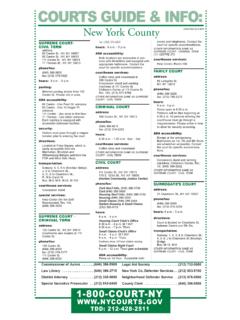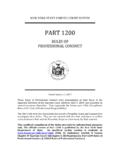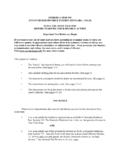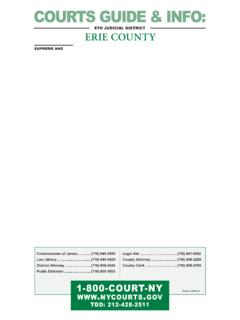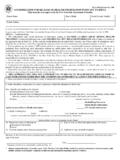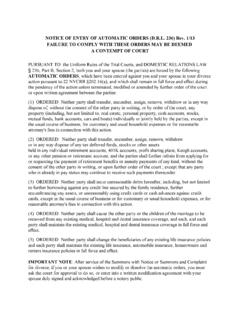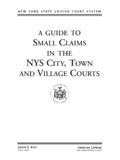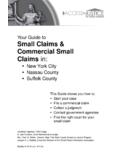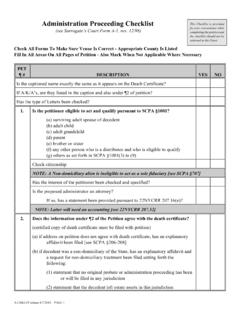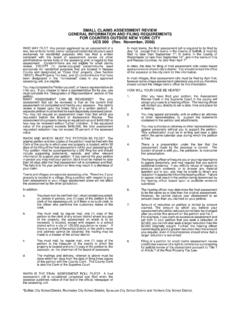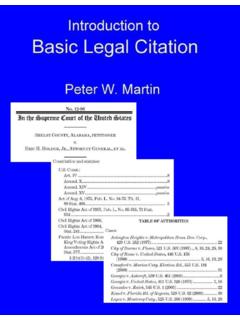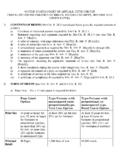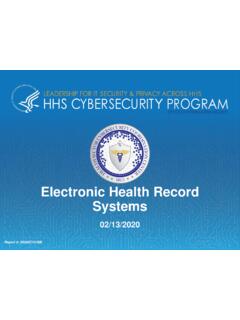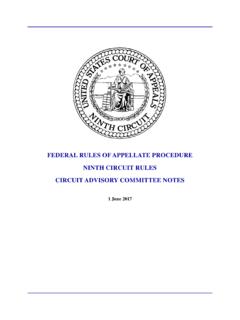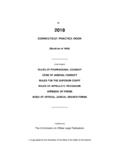Transcription of Practice Rules of the Appellate Division
1 Practice Rules of the Appellate Division Approved by Joint Order of the Departments of the New York State Supreme Court, Appellate Division December 12, 2017. (Revised June 29, 2018). (Revised November 25, 2019). Part 1250 shall apply to all matters that are commenced in the Appellate Division , or in which a notice of appeal to the Appellate Division is filed, on or after September 17, 2018, and Unless otherwise ordered by the Court upon a showing that application of part 1250 to the matter would result in substantial prejudice to a party or would be manifestly unjust or impracticable under the circumstances, part 1250 shall apply to each matter pending in the Appellate Division on September 17, 2018. 1. Practice Rules of the Appellate Division Part 1250. General Provisions and Definitions Settlement or Withdrawal of Motion, Appeal or Proceeding;. Notice of Change in Circumstances Initial Filings; Active Management of Causes; Settlement or Mediation Program Motions Methods of Perfecting Causes Reproduction of Records, Appendices and Briefs Form and Content of Records and Appendices; Exhibits Form and Content of Briefs Time, Number and Manner of Filing of Records, Appendices and Briefs Dismissal of a Matter Additional Rules Relating to Criminal Appeals Transferred Proceedings Original Special Proceedings Miscellaneous Appeals and Proceedings Calendar Preference; Calendar Notice; Oral Argument; Post- Argument Submissions Decisions, Orders and Judgments; Costs; Remittitur; Motions for Reargument or Leave to Appeal to the Court of Appeals Fees of the Clerk of the Court 2.
2 Part 1250. Provisions and Definitions (a) Unless the context requires otherwise, as used in this Part: (1) The word cause or matter includes an appeal, a special proceeding transferred to the Appellate Division pursuant to CPLR 7804 (g), a special proceeding initiated in the Appellate Division , and an action submitted to the Appellate Division pursuant to CPLR 3222 on a case containing an agreed statement of facts upon which the controversy depends. (2) Any reference to the court or the Appellate Division means the Appellate Division of the Supreme Court of the State of New York for the Judicial Department having jurisdiction over the cause or matter; any reference to a justice means a justice of that court; any reference to the clerk means the clerk of that court or a designee, unless the context of usage indicates the clerk of another court. (3) Wherever reference is made to a judgment, order or determination, . it shall also be deemed to include a sentence.
3 (4) The word consolidation refers to the combining of two or more causes arising out of the same action or proceeding in one record or appendix and one brief . (5) The phrase cross appeal refers to an appeal taken by a party whose interests are adverse to a party who previously appealed from the same order or judgment as relates to that appeal and cross appeal. (6) The word concurrent, when used to describe appeals, shall refer to those appeals which have been taken separately from the same order or judgment by parties whose interests are not adverse to one another as relates to those appeals. (7) The word appellant shall refer to the party required to file the initial brief to the court in a cause or matter, including an appellant, a petitioner, an appellant-respondent and similar parties. 3. (8) The term NYSCEF shall mean the New York State Courts electronic Filing System and the NYSCEF site shall mean the New York State Courts electronic Filing System website located at (9) The phrase filed electronically, when used to describe submissions to a court, shall refer to documents that have been filed by electronic means through the NYSCEF site.
4 (10) The phrase electronic means shall mean any method of transmission of information between computers or other machines, other than facsimile machines. (11) The phrase hard copy shall mean a document in paper format. (12) The phrase digital copy shall mean a document in text-searchable portable document format and otherwise compliant with the technical requirements established by the court. (b) Number of Justices. When a cause is argued or submitted to the court with four justices present, it shall, whenever necessary, be deemed submitted also to any other duly qualified justice of the court, unless objection is noted at the time of argument or submission. (c) Filing and Service; Weekends and Holidays. (1) Filing (i) electronic filing. For the purpose of meeting deadlines imposed by court rule, order, or statute, all records on appeal, briefs, appendices, motions, affirmations and other submissions filed electronically will be deemed filed as of the time copies of the submissions are transmitted to the NYSCEF site.
5 The filing of additional hard copies of such electronic filings pursuant to court Rules shall not affect the timeliness of the filing. (ii) Hard copy filing. For the purpose of meeting deadlines imposed by court rule, order or statute, all records on appeal, briefs, appendices, motions, affirmations and other submissions not filed 4. electronically will be deemed filed as of the time hard copies of the submissions are received and stamped by the office of the clerk. (iii) A document deemed filed for purposes of timeliness under this rule may thereafter be reviewed and rejected by the clerk for failure to comply with any applicable statute, rule or order. (2) Proof of Service. All hard copy filings shall be accompanied by proof of service upon all necessary parties pursuant to CPLR 2103. (3) Service by Mail and Overnight Mail. If a period of time prescribed by this Part is measured from the service of a record, brief or other submission and service is by mail, five days shall be added to the prescribed period.
6 If service is by overnight delivery, one day shall be added to the prescribed period. (4) Service by electronic Mail Upon Consent. Unless otherwise directed by the court, parties in matters not subject to e-filing may agree, in writing, to service of submissions by electronic mail. A copy of any such agreement shall be filed with the court with the affidavit of service. (5) Weekends and Holidays. If a period of time prescribed by this Part for the performance of an act ends on a Saturday, Sunday or court holiday, the act will be deemed timely if performed before the close of business on the next business day. (d) Signing of documents. The original of every hard copy document submitted for filing in the office of the clerk of the court shall be signed in ink in accordance with the provisions of section (a) of this Title. Copies of the signed original shall be served upon all parties to the matter and shall be filed in the office of the clerk whenever multiple copies of a submission are required to be served and filed in accordance with the provisions of this Part.
7 Documents filed electronically shall be signed in accordance with the provisions of the Appellate Division Rules for electronic Filing. (e) Confidentiality and Sealing. (1) Records, briefs and other submissions filed in matters deemed confidential by law shall not be available to the public except as provided by statute or rule. 5. (2) Appeals and proceedings that are confidential by law include, but are not limited to: (i) Matters arising pursuant to the Family Court Act (Family Court Act 166). (ii) Matrimonial actions and proceedings (Domestic Relations Law . 235; CPLR 105 [p]). (iii) Adoption proceedings (Domestic Relations Law 114). (iv) Youthful offender adjudications (CPL [2]; ). (v) Proceedings pursuant to article 6 of the Social Services Law (Social Services Law 422 [4] [a]). (vi) In criminal matters not otherwise confidential, records of grand jury proceedings (CPL [4]), grand jury reports (CPL ). and presentence reports and memoranda (CPL ).
8 (vii) Proceedings pursuant to Civil Rights Law 50-b. (viii) Proceedings pursuant to Judiciary Law 90 (10). (3) Applications for sealing and unsealing court records shall be made by motion, upon good cause shown. (4) In a civil cause, documents that are subject to an existing sealing order from another court shall remain subject to such order, except as otherwise ordered by the Appellate Division . (f) Appellate Division Numbers. All documents filed with the court shall prominently display the name of the court of original instance, the index number or indictment number of the case in such court, if any, and any number assigned by the Appellate Division . (g) Rejection for Noncompliance. The clerk may reject any submission that does not comply with this Part, is incomplete, is untimely, is not legible, or fails to 6. comply with any applicable statute, rule or order. The court may waive compliance by any party with any provision of this Part.
9 (h) Sanctions. An attorney or party who fails to comply with a rule or order of the court or who engages in frivolous conduct shall be subject to such sanction as the court may impose. The imposition of sanctions and costs may be made upon motion or upon the court's own initiative, after a reasonable opportunity to be heard. The court may impose sanctions and/or costs upon a written decision setting forth the conduct on which the imposition is made. (i) electronic Filing Rules . The Rules of this Part shall be read in conjunction with the electronic Filing Rules of the Appellate Division (22 NYCRR Part 1245). Where there is a conflict between this Part and Part 1245 in an Appellate e-filed matter, Part 1245 shall control. Settlement or Withdrawal of Motion, Appeal or Proceeding; Notice of Change in Circumstances (a) Withdrawal of Motion. A moving party may file a written request to withdraw a motion at any time prior to its determination.
10 (b) Withdrawal or Discontinuance of Appeal or Proceeding. (1) Unperfected appeals, or proceedings where issue has not been joined, may be withdrawn and discontinued by letter application to the court, with service on all parties. (2) An appeal that has been perfected or a proceeding where issue has been joined may be withdrawn and discontinued by leave of the court upon the filing with the court of a written stipulation of discontinuance signed by the parties or their attorneys and, in criminal appeals, by the appellant personally. Absent such a stipulation, an appellant may move for permission to withdraw such an appeal or proceeding. An appeal that has been perfected in the Second Judicial Department and in which no respondent's brief has been filed may be withdrawn by letter application to the court, with service on all parties. (c) Notice of Change of Circumstances. The parties or their attorneys shall immediately notify the court when there is a settlement of a matter or any issue 7.
